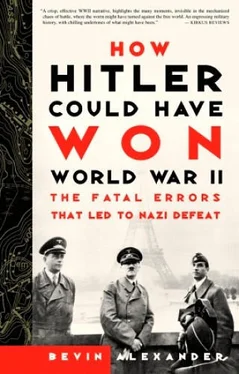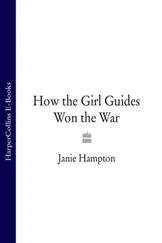Meanwhile on August 20, George Patton, aggravated at Bradley and Montgomery for letting the Germans slip through their fingers, turned his sights eastward—toward the final liberation of France and the invasion of Germany. He ordered an immediate, open-throttled advance on Melun, Montereau, and Sens, all towns a few miles southeast of Paris, using 20th Corps under Walton Walker, and 12th Corps, now under Manton Eddy (Gilbert Cook had high blood pressure). He told Eddy to forget about his flanks and advance fifty miles a day.
Walker’s tanks got to Melun, Montereau, and Fontainebleau on the upper Seine on August 21, and kept going. Eddy liberated Sens and quickly moved on forty miles and captured Troyes. Everywhere the bridges were still intact, opposition nil.
In his diary, Patton wrote: “We have, at this time, the greatest chance to win the war ever presented. If they will let me move on with three corps, two up and one back, on the line of Metz-Nancy-Épinal, we can be in Germany in ten days…. It is such a sure thing that I fear these blind moles [Montgomery, Bradley] don’t see it.”
Actually, Bradley did accept Patton’s plan, on August 25, and told him he could go east toward Metz and Strasbourg. The problem was not Bradley but availability of gasoline.
With the Germans withdrawing from the lower Seine and Manton Eddy’s corps already eighty-five miles southeast of Paris at Troyes, the French capital was ripe for the picking. However important the liberation of the City of Light was to the world, it was virtually empty of German combat troops, and Bradley wanted to bypass it. But on August 19 the Resistance rose in Paris, and challenged the German commander, Dietrich von Choltitz, who had received orders from Hitler to defend the city to the end, then destroy it. Immense pressure developed to get Allied troops into the city, and Bradley succumbed, sending in Leclerc’s French 2nd Armored Division, followed by the U.S. 4th Infantry Division. When Hitler learned that Allied troops were entering the capital, he asked his staff: “Brennt Paris?” Is Paris burning? Choltitz did not burn Paris but signed an armistice with the Resistance.
The movement of the Frenchmen to the city set off wild celebrations, and, as Bradley remembered it, “Leclerc’s men, nearly overwhelmed with wine and women, rolled and reeled into Paris on August 25.” Two days later, Eisenhower, Bradley, and Gerow met Charles de Gaulle at Paris police headquarters, where de Gaulle had already set up his base. Eisenhower allowed Leclerc’s division to remain in Paris to give de Gaulle a show of political strength, but when de Gaulle demanded a victory parade, Eisenhower resolved to make it clear that de Gaulle had received Paris by the force of Allied arms. He ordered the U.S. 28th Infantry Division to parade down the Champs-Elysées on August 29—and keep right on going eastward into action. Bradley remembered it a bit differently. He had refused to let Leclerc’s division take part, he wrote, because Leclerc’s men “had disappeared into the back alleys, brothels, and bistros.”
The senior Allied commanders had been talking about how to defeat Germany as fast as possible. Montgomery wanted both army groups to advance northeast in a “solid mass” of forty divisions toward Antwerp, Brussels, Aachen, and the Ruhr—with himself in command.
Bradley favored a twofold advance, Montgomery’s army group northward and his army group northeastward through Nancy and Metz toward the Saar industrial region and central Germany. This was better tank country than Montgomery’s route, which led over many rivers and canals. However, Montgomery’s route lay through the Pas de Calais, where the V-1s were being fired on London, and the rumor was that the V-2s were about to be launched from there. Much of Allied airpower was challenging the V-1s instead of striking at German synthetic oil production, which was a major factor in Hitler’s ability to continue the war. Also, Antwerp and Rotterdam, two great ports, were in this direction, and the Allies badly needed ship berths.
As a consequence, Eisenhower decided—over Patton’s bitter opposition—that Hodges’s 1st Army with nine divisions, plus a new airborne corps of three divisions under Matthew Ridgway, be allocated to Montgomery, giving him twenty-five divisions, leaving Patton with fifteen divisions to advance toward the Saar.
Divisions were not the whole issue. A severe shortage of supplies was developing, since few ports were open, and, as the armies rushed toward Germany, distances increased by the day. Eisenhower allocated the lion’s share to Montgomery. Hodges, for example, got 5,000 tons of supplies a day, Patton 2,000 tons.
Both the northern and the eastern thrusts commenced at once. By August 31 spearheads of Patton’s army crossed the Meuse River at Verdun, and the next day patrols pushed unopposed to the Moselle River near Metz, thirty-five miles farther east. They were barely thirty miles from the Saar on the German frontier, and fewer than a hundred miles from the Rhine River. But Patton’s main body had run out of gasoline, and did not move up to the Moselle till September 5. By that time the Germans had scraped together five weak divisions to hold the river line. Patton became stuck in an attack on the fortified city of Metz and nearby points, and got no farther.
Meantime the spearhead of Montgomery’s British 2nd Army swept into Brussels on September 3, and the next day another armored force raced on to Antwerp and captured the docks undamaged. Antwerp also was fewer than a hundred miles from the Rhine and entry into the Ruhr, Germany’s industrial heartland.
At this moment, the Germans had nothing to oppose Montgomery. As Basil H. Liddell Hart wrote: “Rarely in any war has there been such an opportunity.” But here Montgomery failed. His spearhead paused to “refit, refuel, and rest,” resumed its advance on September 7, but pushed only eighteen miles farther, to the Meuse-Escaut Canal, where the desperate defense of a few German parachute troops halted it.
By mid-September the Germans had thickened their defenses all along the front but were not strong anywhere. Montgomery, instead of intensifying a direct drive eastward through Belgium and southern Holland, now mounted a huge fourteen-division thrust northward (Operation Market-Garden) on September 17 to get over the Rhine at Arnhem, Holland, using the recently formed 1st Allied Airborne Army to clear the path. His aim, not approved by Eisenhower, was an end run around the Ruhr and a direct strike at Berlin.
But the massive rivers running through Holland imposed severe barriers, and British tanks had to follow a single causeway from Antwerp to Arnhem. The Germans checked the thrust before it reached its goal. A large part of the British 1st Airborne Division dropped at Arnhem—“a bridge too far” for the rest of the Allies to reach, as described in Cornelius Ryan’s book of the same name. Here the British paras were cut off and forced to surrender, a struggle that became legendary for its heroism.
The failure of both Montgomery and Patton to breach the West Wall and get into the heart of Germany in September 1944 has been the center of a controversy that has raged ever since. Both sides claimed they could have won the war if only the other had not got the necessary gasoline.
Patton, when his fuel supplies were petering out, rushed into Bradley’s headquarters “bellowing like a bull” and roared: “To hell with Hodges and Monty. We’ll win your goddam war if you’ll keep 3rd Army moving.” Montgomery opposed any diversion of supplies to Patton, and his complaints became stronger after his thrust at Arnhem miscarried.
The truth is messier. German General Siegfried Westphal, who took over as chief of staff for the western front on September 5, wrote that the entire German line “was so full of gaps that it did not deserve this name. Until the middle of October, the enemy could have broken through at any point he liked with ease, and would then have been able to cross the Rhine and thrust deep into Germany almost unhindered.”
Читать дальше


![Джонатан Димблби - Barbarossa - How Hitler Lost the War [calibre]](/books/385421/dzhonatan-dimblbi-barbarossa-how-hitler-lost-the-w-thumb.webp)









